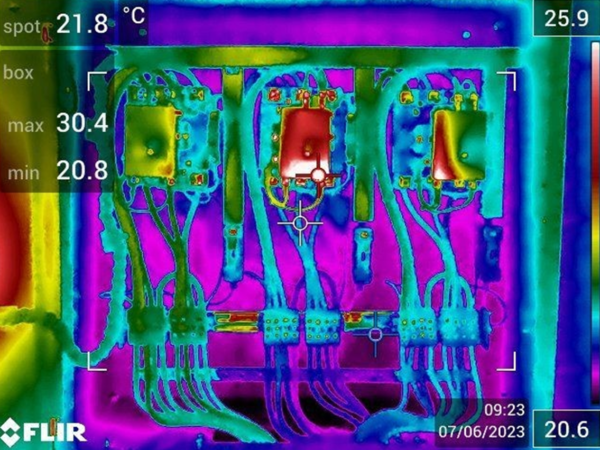There are many issues that can be identified during infrared inspections on electrical systems, they are as follows:
- Electrical Hot Spots: Areas that are significantly hotter than their surroundings, indicating potential issues like overloaded circuits or faulty components.
- Loose or Corroded Connections: These can cause increased resistance and heat, leading to potential failures or fire hazards.
- Overloaded Electrical Circuits: Circuits carrying more current than they are designed for can overheat and fail.
- Faulty or Damaged Electrical Components: Defective parts such as transformers, motors, or capacitors can generate excess heat.
- Breaker and Wire Crimp Issues: Poorly crimped wires or faulty breakers can show up as hot spots.
- Electrical Current Unbalance: Uneven distribution of electrical load can cause overheating in certain parts of the system.
Any of the above issues, if left unchecked, can lead to significant safety hazards, including electrical failures and fires. Regular thermal imaging inspections can help in early detection and prevention.

Useful Data Collected for the Post-infrared Inspection
- Analyse Data: Review and analyse the thermal images and data collected.
- Report Findings: Prepare a detailed report with visual proof of any issues detected.
- Recommendations: Provide recommendations for repairs or further investigation based on the findings.
What happens if we detect hotspots
If we detect a hot spot during a thermal imaging survey, we let our clients know so they can action the following pathway:
- Identify the cause of the hotspot: so clients can check if the hot spot is due to a loose connection, overloaded circuit, or faulty component.
- Always ensure a safety-first approach: you should always ensure the area is safe before proceeding with any repairs or inspections. Turn off the power to the affected circuit if necessary.
- Inspect and repair: Have a qualified electrician inspect the hot spot. They may need to tighten connections, replace faulty components, or redistribute the load as necessary.
- Document the Issue: Record the location, temperature, and any other relevant details of the hot spot for future reference, as this can help with trend analysis of components etc.
- Re-test the hotspot areas: After repairs have been made to the electrical system, perform another electrical thermal imaging inspection to ensure the issue has been fully resolved.
It’s crucial to address hot spots promptly to prevent potential hazards like electrical fires or equipment failure. If you’re unsure about any step, please get in touch and we can explain the benefits of a thermal imaging survey.

Our premium infrared inspection service
Our premium infrared inspection service includes the following:
- Level 3 thermographic certification
- Level 3 qualified electrical thermographers
- Large format FLIR cameras with 45-degree lenses with high sensitivity
- A detailed and comprehensive thermal imaging survey with fault diagnosis
If you have a building that needs an electrical infrared inspection and/or further questions in regard to the above, please don’t hesitate to call me on 07775 623464 or email me at darren@aptsoundtesting.co.uk
